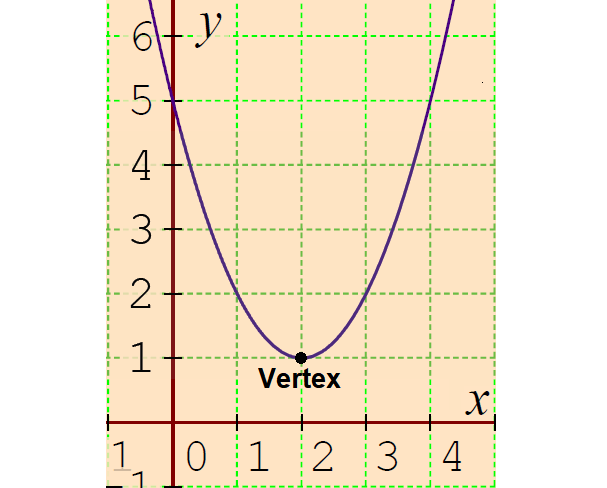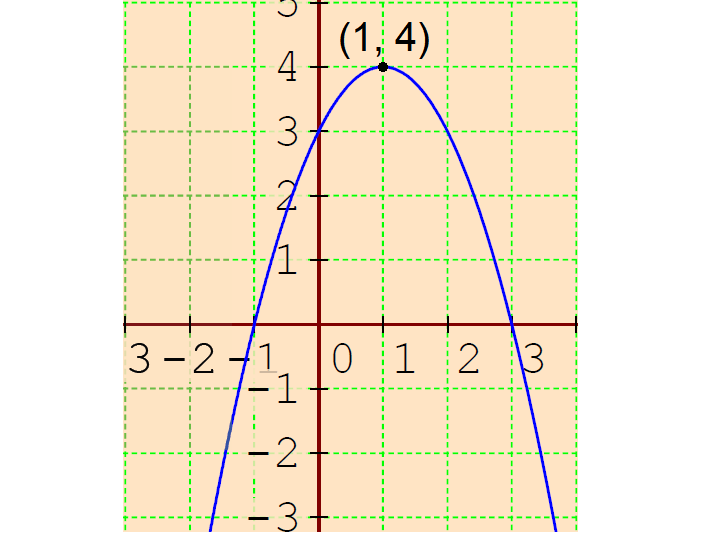VERTEX FORM OF A QUADRATIC FUNCTION WORKSHEET
1. Write the quadratic function in vertex form whose graph is shown below.

Questions 2-4 : Write the quadratic function in vertex form and write its vertex.
2. f(x) = x2 + 6x + 9
3. f(x) = -x2 - 2x - 2
4. f(x) = 4x2 + 16x + 5
5. Write the following quadratic function in vertex form and sketch its graph :
f(x) = -x2 + 2x + 3

1. Answer :

The parabola above opens up with vertex (2, 1).
Vertex form of a quadratic function :
f(x) = a(x - h)2 + k
Substitute vertex (h, k) = (2, 1).
f(x) = a(x - 2)2 + 1 ----(1)
The y-intercept of the parabola is (0, 5). That is, the parabola is passing through (0, 5).
Substitute x = 0 and y = 5.
5 = a(0 - 2)2 + 1
5 = a(- 2)2 + 1
5 = 4a + 1
Subtract 1 from both sides.
4 = 4a
Divide both sides by 4.
1 = a
Substitute a = 1 in (1).
f(x) = 1(x - 2)2 + 1
2. Answer :
Vertex form of the quadratic function :
f(x) = x2 + 6x + 9
f(x) = x2 + 2(x)(3) + 32
f(x) = (x + 3)2
Vertex :
Comparing y = a(x - h)2 + k and f(x) = (x + 3)2,
h = -3 and k = 0
So, the vertex is (h, k) = (-3, 0).
3. Answer :
Vertex form of the quadratic function :
f(x) = -x2 - 2x - 2
f(x) = -(x2 + 2x) - 2
f(x) = -[x2 + 2(x)(1) + 12 - 12] - 2
f(x) = -[(x + 1)2 - 12] - 2
f(x) = -[(x + 1)2 - 1] - 2
f(x) = -(x + 1)2 + 1 - 2
f(x) = -(x + 1)2 - 1
Vertex :
Comparing f(x) = a(x - h)2 + k and f(x) = -(x + 1)2 - 1,
h = -1 and k = -1
So, the vertex is (h, k) = (-1, -1).
4. Answer :
Vertex form of the quadratic function :
f(x) = 4x2 + 16x + 5
f(x) = 4(x2 + 4x) + 5
f(x) = 4[x2 + 2(x)(2) + 22 - 22] + 5
f(x) = 4[(x + 2)2 - 22] + 5
f(x) = 4[(x + 2)2 - 4] + 5
f(x) = 4(x + 2)2 - 16 + 5
f(x) = 4(x + 2)2 - 11
Vertex :
Comparing f(x) = a(x - h)2 + k and f(x) = 4(x + 2)2 - 11,
h = -2 and k = -11
So, the vertex is (h, k) = (-2, -11).
5. Answer :
Vertex form of the quadratic equation :
f(x) = -x2 + 2x + 3
f(x) = -(x2 - 2x) + 3
f(x) = -[x2 - 2(x)(1) + 12 - 12] + 3
f(x) = -[(x - 1)2 - 12] + 3
f(x) = -[(x - 1)2 - 1] + 3
f(x) = -(x - 1)2 + 1 + 3
f(x) = -(x - 1)2 + 4
Vertex :
Comparing f(x) = a(x - h)2 + k and f(x) = -(x - 1)2 + 4,
h = 1 and k = 4
So, the vertex is (h, k) = (1, 4).
To graph the above quadratic equation, we need to find x-intercept and y-intercept, if any.
x-intercept :
To find the x-intercept, substitute f(x) = 0.
0 = -(x - 1)2 + 4
(x - 1)2 = 4
Take square root on both sides.
x - 1 = ±√4
x - 1 = ±2
x - 1 = -2 or x - 1 = 2
x = -1 or x = 3
So, the x-intercepts are (-1, 0) and (3, 0) .
y-intercept :
To find the y-intercept, substitute x = 0.
f(0) = -(0 - 1)2 + 4
= -(-1)2 + 4
= -1 + 4
= 3
y = 3
So, the y-intercept is (0, 3).
Comparing f(x) = a(x - h)2 + k and f(x) = -(x - 1)2 + 4,
a = -1
So, the parabola opens down with vertex (1, 4), x-intercepts (-1, 0) and (3, 0) and y-intercept (0, 3).

Kindly mail your feedback to v4formath@gmail.com
We always appreciate your feedback.
©All rights reserved. onlinemath4all.com
Recent Articles
-
Digital SAT Math Problems and Solutions (Part - 145)
Apr 16, 25 12:35 PM
Digital SAT Math Problems and Solutions (Part - 145) -
Digital SAT Math Problems and Solutions (Part - 144)
Apr 14, 25 07:27 PM
Digital SAT Math Problems and Solutions (Part - 144) -
Quadratic Equation Problems with Solutions (Part - 1)
Apr 14, 25 11:33 AM
Quadratic Equation Problems with Solutions (Part - 1)

